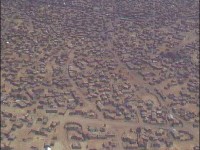 Upgrading of informal settlements
Land tenure
Urban planning
Upgrading of informal settlements
Land tenure
Urban planning
Location:Nouakchott and Nouadhibou, Mauritania
Organizers:
Groupe de Recherches et d’Échanges Technologiques (GRET)
World Bank
Commissariat aux Droits de l’Homme, à la Lutte Contre la Pauvreté, et à l’Insertion
Background: In the 1970s and 1980s, severe droughts and desertification in the Sahel region destroyed the nomadic way of life in Mauritania and spurred significant eco-migration to Nouakchott and Nouadhibou, the two largest cities. From 1977 to 2000, the population in Nouakchott increased from 134,700 to approximately 728,600, with an average annual growth rate of over 7 per cent. Nouadhibou almost quintupled from 21,900 in 1997 to 107,900 in 2000. The cities had to accommodate large influxes of nomadic people settling on the urban periphery. The Twizé programme was conceived to alleviate the hardships endured by the settlers and manage chaotic urban growth.
Project: In 1998, Groupe de Recherches et d’Échanges Technologiques (GRET), a professional solidarity and international cooperation association, established the Twizé programme to improve access to affordable housing and living conditions for lower-income residents and poor eco-migrants. In 2003, the programme expanded with financial support from the World Bank and the government. GRET collaborated with the Mauritanian Commissariat aux Droits de l’Homme, à la Lutte Contre la Pauvreté, et à l’Insertion, the municipality of Nouakchott and non-governmental organizations in order to:
- streamline regularization of land tenure
- improve access to microcredit for housing improvements
- create microenterprises
- build the capacity of community members to undertake infrastructure improvements
The initial pilot project demonstrated that marginalized settlements could be transformed into viable neighborhoods. At the end of the first phase, the 130 families who participated in the pilot had managed to double the size of their homes and increase the value of the land and structure by a factor of four. Loan repayment rates were very high (close to 100 per cent).
However, rising construction and infrastructure costs substantially increased the subsidies needed to cover the widening gap between the affordability of the target group and the cost of land and housing. The construction cost of the basic module quadrupled between 1998 and 2005 from MUR 110,000 (USD 390) to MUR 400,000 (USD 1,413.43). Despite the doubling of participants’ contributions, the subsidies provided increased from 27 to 67 per cent of the total cost, eroding the program’s financial viability. Following the termination of the World Bank funding (USD 15 million over five years), the project ended.
Results: At the conclusion of the program in 2008, 6,000 houses had been constructed. Residents indicated that they felt safer and more financially secure. They were also able to divert money saved on housing to start or expand income generating activities and eventually purchase other assets. The program enhanced the skills of the masons constructing the dwellings and improved communication among the laborers, creditors and beneficiaries. It provided skills training for workers in a variety of fields, including craftsmanship and textiles as well as literacy training. The program facilitated the mobilization and involvement of residents in the planning process. The property titles issued and the permanent construction and investments in the homes encouraged residents to settle in that location, reducing the repeated displacement of poor families further out to the urban periphery in a rapidly expanding urbanized area.
Institutionally, Twizé offers a model of partnership between national and local governments, communities, development organizations and NGOs providing technical assistance and capacity building. In its early phases, it worked remarkably well. It underscored the link between organized settlements and poverty alleviation. Rising costs far outstripped the affordability of residents and local authorities and undermined the sustainability of the program’s operational modalities, which were not adjusted to respond to the growing imbalance. However, the partnership concept to address the challenge of urban poverty alleviation and social inclusion by improving the lives of slum dwellers remains a valid and effective approach towards achieving the Millennium Development Goal Target.
Transferability: This case-study was prepared in 2001 by the Center for Urban Development Studies (I2UD’s precursor) for the government of Mauritania as it crafted it’s National Urban Development Strategy. The Twize program was considered a good practice in land regularization and informal settlement upgrading. The case study has since been used as part of the UN-Habitat’s State of the Arab Cities 2012 report.
Sources:Center for Urban Development Studies. (2001). Case Study on the Twizé programme. Cambridge: CUDS.
Wahba, S. (2002). From land distribution to integrated development: the evolution and impact of shelter and poverty alleviation policies in marginalized settlements in Nouakchott, Mauritania. Cambridge: Harvard.
Choplin, A. (2009). Répondre au défi de l’habitat social dans les villes du Sud: l’exemple du programme Twise en Mauritanie. Les Editions du Gret: Etudes et Travaux en Ligne #23.
GRET. “Twize, 10 ans de développement social urbain en Mauritanie.” Politiques et perspectives en developpement. Issue 5. May 2012 http://www.gret.org/wp-content/uploads/NPPD_05-fr3.pdf
Pictures courtesy of GRET, Looxlex.


